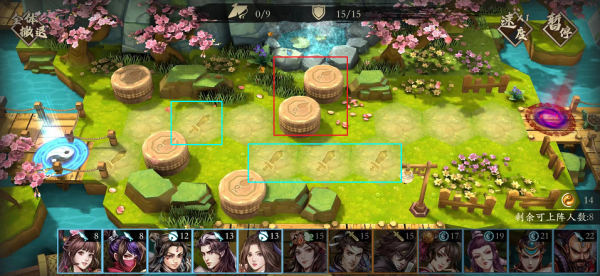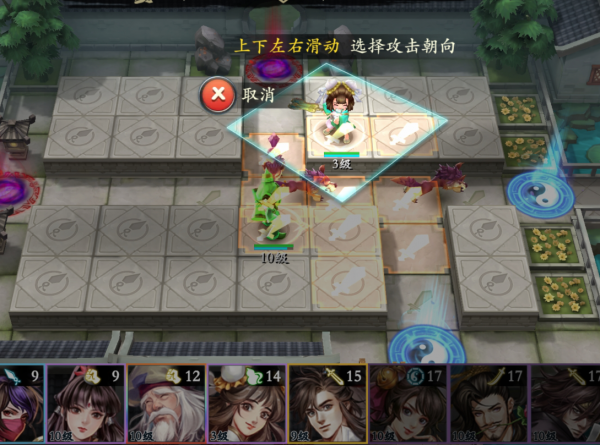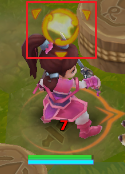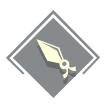"Capture the Flag" is a martial arts strategy tower defense mobile game. It is quite easy to get started. However, the game also has some features that are different from other games. Below, the editor will introduce what novices who are new to "Capture the Flag" must know. The basic mechanism helps players better understand the game, allowing novice players to get started quickly!
1. Basic mechanism
In traditional tower defense games, the enemy advances along a fixed route, and players build defense towers around them to prevent the enemy from reaching the defense point. If the life of the defense point returns to zero, the defense fails. "Capture the Flag" is also based on this mechanism, and then incorporates RPG game elements, adding combat law, animal husbandry system and various agency interactive elements. In this game, the knights entering battle are building defense towers in traditional tower defense games.
1. Cost In "Capture the Flag", the resources that knights need to consume when going into battle are called [cost]. Unlike traditional tower defense, where you kill enemies to obtain gold resources, the cost here will slowly recover over time. At the same time, the skills of the knights of the [Fist] profession will provide players with a large amount of fees, so the earlier you enter the [Fist] profession, the more abundant the cost will be.

2. Map terrain In "Capture the Flag", the terrain is divided into two types, high platform and ground. For example, the red framed grid in the picture below. A high platform with a dart pattern painted on it is a high platform. The high platform can place remote knights, such as [ Dart], [Skill], [Medical] and most of the [Auxiliary]; and in the picture below, the grid with the sword icon drawn in the blue box is the ground, and most melee units can only be placed on the ground, such as [ Fist], [Shield], [Sword], [Knife] and a small number of [auxiliary], etc. Extremely special knights may ignore terrain restrictions. In battle, the knight's position is a very important strategy, even more important than direction selection.

3. Blocking the knight placed on the ground can block the advancing enemies. The number that can be blocked is the knight's blocking attribute. For example, a knight (sword profession) with a blocking number of 2 can block 2 enemies walking on the ground (flying enemies cannot be blocked, and some BOSS may be equivalent to 2-3 enemies, requiring a high-blocking knight).
Each vigilante that can be placed in the ground area will have the attribute "number of blocks". In the game, placing the vigilante in the correct position to block the enemy's progress, and at the same time using output to kill is the most basic and core strategy in the game.
4. Attack direction The choice of attack direction is the second core strategy of "Capture the Flag". In "Capture the Flag", different knights' attack ranges cover different ground grids. As long as it is yellow, the knights can attack the range (as shown in the picture). At the same time, the knights can choose any direction of 360 degrees. When selecting a direction, monsters covered by the attacking vigilante will turn red; friendly vigilantes covered by the healing vigilante will turn green.
It should be noted that once the direction is selected, it cannot be changed unless death occurs and the player returns to battle.

5. Resurrection Resurrection is one of the core mechanisms of "Capture the Flag". Proper use of the vigilante's resurrection to set up formations is the third core strategy of the game.
After the knight enters the battle, you can choose to take the initiative to leave the knight. At this time, half of the cost of the knight's battle will be returned to the player, and the knight enters the state of waiting for resurrection. After the resurrection CD is over, the knight can enter the battle again. It should be noted that, The vigilante needs to spend more money every time he goes into battle.
Flexible use of the knight's retreat and resurrection is the interesting part of the strategy in the game. Using resurrection, you can adjust the direction of the knight's attack, target specific enemies, adjust the defense line, and quickly release the knight's skills.

6. Skills In "Capture the Flag", the energy consumed by knights using skills is called infuriating energy. To release skills, you need to go through the cycle of "Infuriating recovery → Casting skills → Infuriating recovery → Casting skills". Some knights' skills require more Infuriating energy, but they have a certain initial amount of Infuriating energy when they go into battle, which makes it difficult to If they directly go out of battle and wait for resurrection after using their skills, it will take less time than waiting for them to naturally recover their Qi. This is also one of the resurrection strategies mentioned above.

The blue one is the Qi reply strip.

Display of skills that can be released
7. In the hatred battle strategy, the order of knights entering the battle is very important. Here we need to understand the hatred mechanism of the game, that is, the priority of monsters attacking knights. The knight with the highest hatred will be attacked first.
Without considering the characteristics of knights:
For the enemy, they will always attack the knight who is within their attack range and is the last to enter the battle.
For knights, priority will be given to attacking the enemy with the shortest remaining distance, unless the knight has a special attack priority.
Therefore, when facing some long-range enemies, first use the crispy output, and then immediately use the shield class with high defense and thick health to protect your own knights and maximize the output. This is also a formation strategy.
8. Damage calculation mechanism In "Capture the Flag", damage is divided into two types: physical damage and internal force damage.
Defense power can reduce the physical damage received by the same amount, physical damage = attack power - defense power; internal force resistance can reduce the internal force damage received in the form of a percentage, internal force damage = attack power * (1 - internal resistance). When the defense in the game exceeds the attack power or the internal force resistance reaches 100%, the guaranteed damage will be triggered, which is 5% of the knight's attack power.
What is special is that some knights have the ability to cause real damage-that is, they can ignore defense, armor and shields and directly deduct the damage from the enemy's health.
9. Sweeping When the player successfully clears the level with three stars without including friends to support the knights in the formation, the sweeping of that level will be unlocked (except bloody battles). A sweep requires a sweep order, and the level will be settled directly to obtain resources.
2. Introduction to knights
"Capture the Flag" can be divided into eight major professions, but knights belonging to the same profession will have some common professional characteristics, but each knight is unique. It can be understood that each knight is a different defense tower.
1. Dart

The high-level long-range knight mainly deals physical damage.
Usage: Compared with spells of the same strength, Dart has lower cost and faster attack speed.
It will give priority to attacking air enemies and is the main occupation to deal with air enemies.
This is very important. If you do not have this profession in some levels, you will not be able to defeat the flying enemies. Therefore, it is recommended that everyone cultivate one or two knights with the dart profession.
2. Technique

The high-level long-range knight mainly deals internal damage.
Usage: Compared with Dart, the cost is slightly higher, the attack speed is slightly slower, and there is no priority against air.
It can attack air units, but is generally not used as the main anti-air force. It is generally used to deal with high-defense enemies.
It is worth mentioning that due to the damage calculation mechanism, if the enemy's defense power and internal force resistance are not much different, it is usually much more effective to use internal force damage. Therefore, when dealing with a large number of enemies, group attack techniques are often more suitable than group attack darts.
The group attack knight is usually used in conjunction with the shield. The shield knight can block multiple enemies, while the group attack knight takes the opportunity to deal damage.
3.Shield

Ground melee warrior, mainly dealing physical damage.
Usage: Responsible for blocking enemies, taking damage, and attracting the hatred of remote enemies.
Most shield professions have a high blocking value and can block 3, and some of them have the ability to heal. They can only block 2 before the governor channel is opened. However, they can be paired with the dart profession, and only two knights can defend the path with less pressure. And when the high platform position is tight, treatment can also be assisted on the ground.
4. punch

Ground melee warrior, mainly dealing physical damage.
Usage: Low cost, quick to enter the battle, stand in the field in the early stage and be responsible for the recovery cost.
Boxing is currently divided into 2 branches:
[Defensive type]
Defensive boxing professions generally block 2 and have skills that automatically restore costs, but their output capabilities are weak. Suitable for placement in non-primary positions for defense and recovery costs.
【Attack type】
The number of blocks for the offensive boxing profession is only 1, but every time you kill an enemy, you can get 1 entry cost, and the entire initial entry cost will be refunded when you exit the formation.
Taking advantage of the characteristic that the initial entry cost will be refunded when the offensive boxing class retreats for the first time, it can temporarily enter the battlefield when the cost is tight at the beginning, and then retreat when the cost is sufficient in the later stage to achieve a cost-free strategy. And since attacking punches usually have higher attack power, they can also be used as low-equipped ground warriors for output.
5.Knife

The ground warrior is mainly responsible for output and auxiliary blocking.
The block of the knife is mostly 2, so it exists as a knight who can resist pressure in the early stage. The attack speed of the knife is slow, but it can attack 2 enemy knights at the same time.
Some knives can become block 3 after turning on the skills, and can be used as the main output + pressure-resistant knight in the mid-term. Can be used with a shield or sword.
6.Sword

The ground knight is mainly responsible for output.
Compared with shield and sword professions, swords have lower defense and fewer blocks, but their output is very high and their output range is long; some swords are physical attacks, and some swords can use internal force to attack. Compared with warlocks who have high-level internal force output, internal force The output sword is more resistant to hits.
Most of the swords are melee attacks, and some swords have the ability to attack from a distance. They can also hit air units. The knights who serve as auxiliary darts are also good.
7.Medical

Gaotai knights are responsible for treating other knights.
Restores the health of other knights within the attack range, which can be divided into single targets and groups. The group can simultaneously heal three friendly parties within the attack range. It is generally a circular range with itself as the center, but the attack speed is slow. The single target is suitable for use when the treatment pressure is low. It is generally a 90-degree fan-shaped range and requires long hands. But the scope is narrow, and group milk has its own advantages and disadvantages.
8.auxiliary

【auxiliary category】
It is mainly used to control enemies or assist teammates. It is generally used to add various debuff BUFFs to enemies, such as slowdown, restraint, stun, etc., and to add BUFFs to teammates, such as additional attacks, to assist in combat. In the * level, auxiliary professions can effectively assist the main knight's output and greatly amplify the main knight's advantages.
basic tactics
In battle, we need to pay attention to the types of enemies, the order and route of monsters, and the threats to our knights, etc. At the same time, we should also learn as much as possible about the skills and characteristics of our knights to flexibly adjust our combat strategies.
3. Advanced skills
1. The usage of punch is to use it as output when the shield or knife pressure is very high in the early stage. Since they will have to retreat sooner or later, they can use their HP to delay the enemy and reduce the damage received by other knights.
2. In some maps, the space suitable for the knights on the high platform is small. The sword can be placed on the side of the enemy's refresh point to assist in reducing the enemy's health. Of course, be careful when encountering long-range enemies and being knocked down.
3. If the knight goes into battle on a grid with enemies, the enemy will be pushed to the edge of the grid. This can be used to push enemies on the ground to the back, reducing the pressure on them to go into battle.
4. After the defense line is constructed, some knights who are temporarily unnecessary can be appropriately withdrawn and put into resurrection cooldown to cope with subsequent situations.
5. When guarding a point where the pressure of two adjacent lanes is obviously different, the attack range of the two opening punches can be staggered in an "X" shape, so that more squares can be covered and the lane with higher pressure can be attacked at the same time.